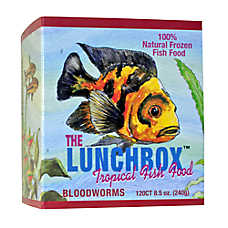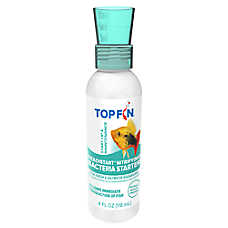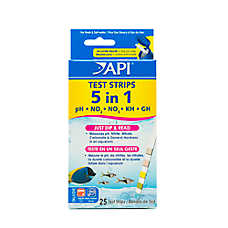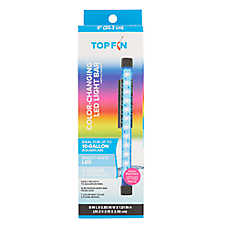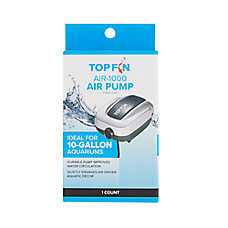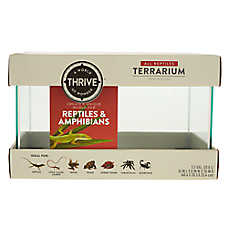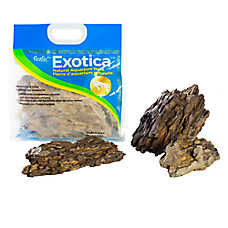Vampire Crabs Care Guide
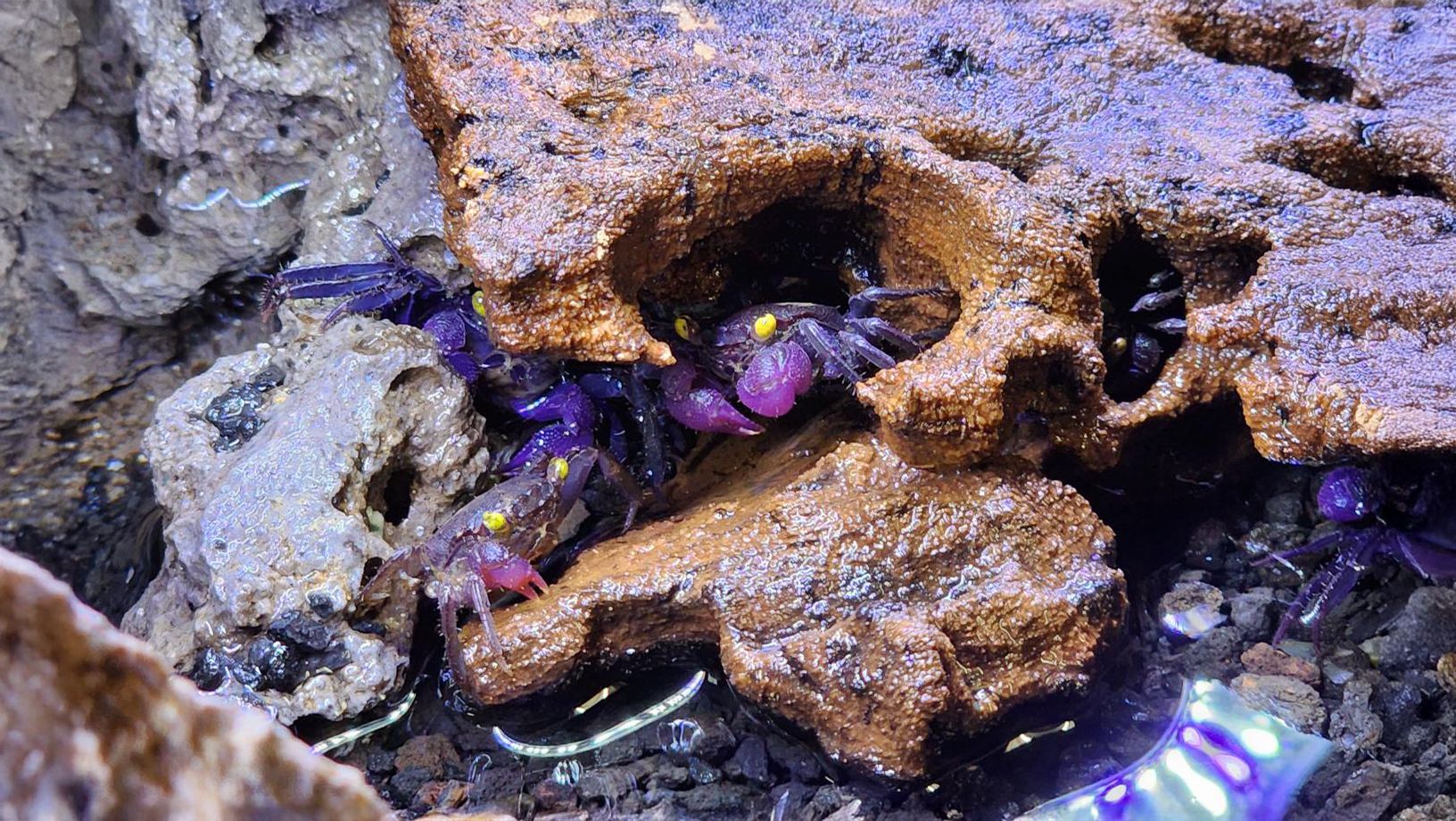
In this Article
Charismatic, Chromatic Crabs!
Vampire crabs (Geosesarma spp.) are a genus of freshwater crabs native to Southeast Asia. Most Vampire Crabs are purple with stunning yellow eyes. They can have distinct color patches on their bodies depending on the species and habitat they originate from. In general, crabs that are the same color do well together since they are the same species from the same habitat. These interesting and beautiful crabs live approximately two and a half years on average and grow to be about 2” wide through the body at full size.
Community: Vampire Crabs are predatory and intolerant of other similar species. They enjoy a bioactive set up with isopods and springtails.
Diet: Vampire Crabs are typically scavengers who eat a variety of insects, plants, and other foods.
Behavior: Vampire Crabs' behavior is generally aggressive. While they live in communities and prefer to live in a group, they can be quite territorial. When keeping crabs as pets, there are no guarantees that the crabs will get along. You should always monitor your crabs for signs of stress or aggression and be prepared to relocate the crab from the aquarium. It can also be helpful to rearrange or add decor to create additional territories and hiding places.
Vampire crabs love to explore their homes, burrow in the substrate, and many like to climb! They are most active at night (makes sense, since vampires don’t like the sun). Each crab will have a different personality. Some like to spend a lot of time in the water. Others prefer to be on the land areas or on top of the decorations!
Setting up your CRABitat!
Vampire crabs are freshwater crabs, but they spend most of their lives alongside rivers and streams, searching for food and digging in the banks. Vampire crabs are considered semi-aquatic, meaning they live primarily on land. They do still need access to water they can fully submerge in. In fact, these water areas are essential to your crab’s molting process! But unlike fish, vampire crabs do not have gills and cannot breathe underwater, so they must be able to get out of the water to survive!
When setting up your paludarium (the technical term for a terrarium that contains both land and water), you will need at least 5 gallons worth of space for every 3 crabs you plan to keep in this set up - keeping in mind that male crabs can become territorial. Your paludarium should be comprised of roughly 20% aquarium area (underwater) and 80% terrarium area (above water),so your crabs have significantly more real estate out of the water than they do in it. Vampire Crabs can be shy, especially when they first come home. They want lots of rocks, branches, and plants for them to explore and hide in.
In the underwater areas of your paludarium, you may be tempted to add fish or snails. Vampire Crabs will prey on snails and may injure fish. Vampire Crabs often live well alongside small freshwater shrimp like Ghost Shrimp or Fancy Shrimp. Larger shrimp like Rock Shrimp are less compatible and should be avoided. Not sure which species can safely share a tank? Review our Fish Compatibility Guide for tips on selecting tank mates.
The first step in setting up your paludarium is choosing your tank. As mentioned earlier, you need at least 5 gallons of space for every 3 crabs so the size of your tank will depend on how many crabs you want.
Ideal Vampire Crab Set Up
For the land portion: Temperature: 71-82°F
Humidity: 75% and up
Tank Size and Area: 5+ Gallons with 75% above water
Habitat: Lots of plants, rocks, and wood on substrate of sand or non-compacted organic soil
For the aquatic portion:
Temperature: 71-78°F
Tank Size and Area: 5+ gallon with 25% underwater
Habitat: Water around 2-4” deep with multiple ways to climb out of the water. Aquarium sand or gravel substrate
Recommended water parameters | |
pH | 7.5 to 8.0 |
Alkalinity | 120-300ppm |
Total Hardness | 120-300ppm |
Ammonia | 0 |
Nitrite | 0 |
Nitrate | Less than 20ppm |
Chlorine | 0ppb |
When should I test my water quality?
- Crabs are sluggish, not moving about the tank
- Crabs are not eating
- Sudden behavior changes in your crabs
- Water is cloudy
- Water smells funny
PetSmart offers free water quality testing and one of our knowledgeable associates can help you get your system balanced.
When should I contact a veterinarian?
Contact an aquatic veterinarian if you notice the following signs:
- Unusual swimming pattern
- Thinness or decreased appetite
- Visible signs of illness or recent fish loss
If you observe any of these symptoms, we recommend visiting the "Find a Fish Vet" tool at fishvets.org or wavma.org to locate a qualified aquatic veterinarian in your area.
SHOPPING CHECKLIST
What will I need for my Vampire Crab habitat?
- Aquarium or terrarium sized appropriately for the number of crabs, with stand
- Tight fitting lid
- Natural sand & gravel vacuum
- Tank décor like driftwood or ornaments
- Live or artificial plants
- Aquarium heater and thermometer
- Aquarium filter sized for your tank
- Water testing kit or strips
- Water conditioner/dechlorinator
- Beneficial bacteria starter
- Algae cleaning pad or scraper
- Insect based flake or pelleted food; live wax worms, springtails, isopods, or mealworms; fruits such as banana and vegetables such as leafy greens
Ready to learn more?
This guide is a great starting place, but we encourage you to do more research on the individual species that you are keeping so that you can be as successful as possible with your aquarium!
Vet Assured™: Pets purchased at PetSmart are part of our exclusive Vet Assured™ program, designed by PetSmart veterinarians to help improve the health and well-being of our pets. Our vendors meet a high
standard in caring for pets and screening them for common illnesses. This program also includes specific standards for in-store pet care.
The PetSmart Promise: If your pet becomes ill during the initial 14-day period, or if you’re not satisfied for any reason, PetSmart will gladly replace the pet or refund the purchase price.
Safety tips for you and your pet:
1. ALL ANIMALS can potentially carry viral, bacterial, fungal, and parasitic diseases contagious to humans. 2. Thoroughly wash your hands with warm, soapy water before and after contact with any pet or its habitat. 3. Adults should assist children with hand washing after contact with a pet, its habitat or aquarium water. 4. Always add a dechlorinator or water conditioner and bacteria starter to tap water before adding it to the aquarium. 5. Do not use soaps or detergents to clean aquarium or decor, since they are toxic to fish. For more information, visit petsmart.com, cdc.gov/healthypets, or contact your veterinarian.
This care guide contains general information for the proper care of your pet, but is not comprehensive and is not a substitute for veterinary advice or care. PETSMART and VET ASSURED are trademarks of PetSmart Home Office, Inc. © 2025 PetSmart. All rights reserved.
standard in caring for pets and screening them for common illnesses. This program also includes specific standards for in-store pet care.
The PetSmart Promise: If your pet becomes ill during the initial 14-day period, or if you’re not satisfied for any reason, PetSmart will gladly replace the pet or refund the purchase price.
Safety tips for you and your pet:
1. ALL ANIMALS can potentially carry viral, bacterial, fungal, and parasitic diseases contagious to humans. 2. Thoroughly wash your hands with warm, soapy water before and after contact with any pet or its habitat. 3. Adults should assist children with hand washing after contact with a pet, its habitat or aquarium water. 4. Always add a dechlorinator or water conditioner and bacteria starter to tap water before adding it to the aquarium. 5. Do not use soaps or detergents to clean aquarium or decor, since they are toxic to fish. For more information, visit petsmart.com, cdc.gov/healthypets, or contact your veterinarian.
This care guide contains general information for the proper care of your pet, but is not comprehensive and is not a substitute for veterinary advice or care. PETSMART and VET ASSURED are trademarks of PetSmart Home Office, Inc. © 2025 PetSmart. All rights reserved.

